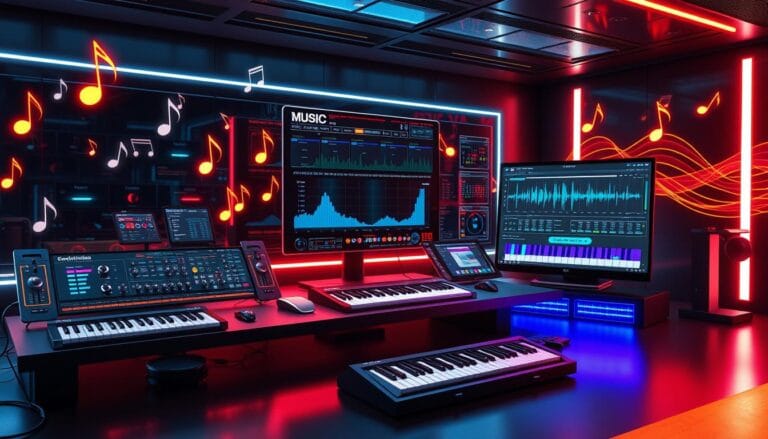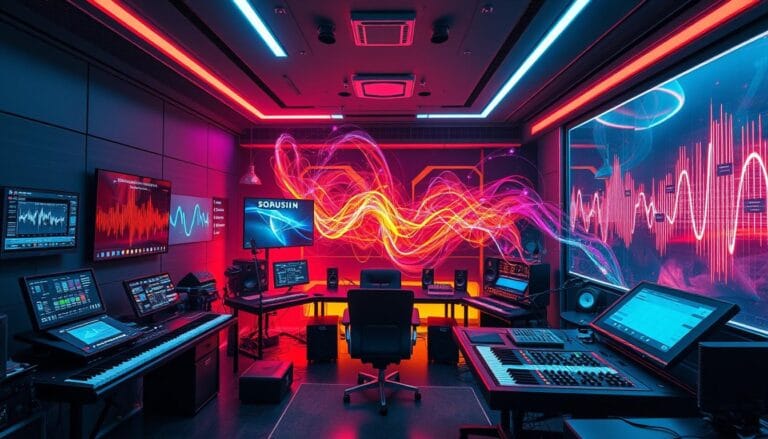Coding Music with AI Prompts: Transform Sonic Pi into Free Music and Sound Effects
I’ve always dreamed of making my own music with the help of artificial intelligence. Now, thanks to Sonic Pi and ChatGPT, that dream is real. These tools have changed how I make music and opened up new creative doors.
Thank you for reading this post, don't forget to subscribe!Sonic Pi lets me create amazing sounds by writing code. ChatGPT helps with music tasks like chord progressions and lyrics. Together, they’ve changed how I make music, letting me explore new ideas.
Table of Contents
Key Takeaways
- Sonic Pi and ChatGPT are changing music creation by letting users code and use AI.
- Sonic Pi is a great tool for coding music and sound effects. ChatGPT helps with songwriting.
- Together, Sonic Pi and ChatGPT open up new creative paths. Users can mix AI content with their music.
- These tools are easy to use and affordable. They make music creation accessible to everyone.
- Using AI in music production can lead to unique and touching songs.
Understanding AI Music Creation Tools
The music world is changing fast, thanks to AI tools. Sonic Pi and ChatGPT are leading this change. They make creating music with code and AI prompts easier than ever.
Introduction to Sonic Pi and ChatGPT Integration
Sonic Pi is a free tool for making music with code. It’s great for musicians and beginners. When you use it with ChatGPT, you get even more creative ideas for your music.
Essential Components of AI Music Production
Good AI music needs to know the basics of music making. This includes drums, leads, bass, vocals, and sound effects. Tempo and genre are also key to the music’s feel.
Setting Up Your Creative Environment
To get the most out of AI music tools, set up your space right. This means getting your hardware and software ready. Knowing Sonic Pi and ChatGPT well helps you make music faster and better.
| AI Music Production Tool | Key Features | Pricing |
|---|---|---|
| Sonic Pi | Code-based music creation, sound manipulation, live coding | Free |
| ChatGPT | AI-powered language model, music composition assistance, lyric generation | Free trial, subscription plans available |
| Amper | Automated music composition, genre-specific music generation, royalty-free tracks | Free trial, subscription plans available |
| AIVA | Emotional soundtrack composition, customizable music generation, music for media | Free trial, subscription plans available |
| Boomy | AI-generated music creation, monetization through social media platforms | Free, with paid subscription options |
Exploring AI music tools opens up new ways to make music. Sonic Pi and ChatGPT are just the start. Start using AI to make your music better today.
Getting Started with Sonic Pi Installation and Setup
Sonic Pi is a free music tool that lets you make and play music with code. To start, download and install it on your computer. It works on Windows, macOS, and Linux, so many people can use it.
After installing Sonic Pi, get to know the interface. It has a code editor for writing music and buttons to play and stop. There are also guides and tutorials to teach you coding music with Sonic Pi.
Sonic Pi Installation Process
- Go to the Sonic Pi website at sonic-pi.net and download the right version for your computer.
- Just follow the steps on your screen to install Sonic Pi.
- After it’s installed, open the Sonic Pi app.
Navigating the Sonic Pi Interface
- The code editor is where you write and edit your music.
- At the top, buttons let you play, stop, and control your music.
- The documentation and tutorials offer great help to learn Sonic Pi coding for music.
Learning how to install and use Sonic Pi’s interface is the first step to exploring its creative possibilities. Get ready to dive into a world of musical creation and coding.
“Sonic Pi allows you to create music and sound effects using code, opening up a world of creative possibilities.”
Fundamentals of Music Theory for AI Composition
Learning the basics of music theory is key when using AI tools like ai music creation and how to make music with chatgpt. Knowing about scales, chord progressions, rhythm, and structure opens up new creative doors. It helps you get the most out of these advanced AI tools.
Scales and Chord Progressions
First, get to know major and minor scales, the base of Western music. Learn how these scales build and how they create harmonious chords. Try different keys and modulations to deepen your music.
Rhythm and Time Signatures
Rhythm is vital in music. Learn common time signatures like 4/4 and 3/4. Play with tempo and syncopation to add mood and energy to your AI music.
Musical Structure and Form
Think about your music’s structure and form. Know common song structures, like verse-chorus-verse. Try different musical paths to make your songs cohesive and engaging.
Mastering these music theory basics will help you create powerful ai music creation and how to make music with chatgpt. Use AI’s strength while keeping your music grounded in music’s basics.
“Music is a universal language that transcends boundaries and connects people from all walks of life. By combining the power of AI with a deep understanding of music theory, you can unlock new realms of creative expression and touch the hearts of listeners around the world.”
Coding Music with AI Prompts
Use AI to create amazing music tracks with Sonic Pi. ChatGPT can help start your creative journey with ideas, melodies, and chord progressions. You can explore many musical styles by making specific prompts.
Start with AI ideas in Sonic Pi and make them your own. Use the software’s features to add to your music. Try out algorithmic composition for unique melodies. Use code to make your music change based on input.
AI and Sonic Pi together open up endless musical possibilities. Generate music tracks for free and explore your creativity. Dive into the world of chatgpt music prompts and let your imagination run wild.
- Craft specific chatgpt music prompts to generate initial ideas, melodies, and chord progressions.
- Implement the AI-generated concepts in Sonic Pi, refining and expanding on them.
- Experiment with algorithmic composition, using code’s randomness to create unique melodies.
- Explore the use of conditional statements, loops, and variables to make your music dynamic.
“The fusion of AI and Sonic Pi is a game-changer for music creation. The possibilities are endless when you unleash your creativity with these powerful tools.”
Let your musical talent shine by coding music with AI prompts. Sonic Pi and ChatGPT are a great team. They help you generate music tracks for free and open up a world of sound.

Creating Dynamic Sound Effects with ChatGPT and Sonic Pi
Explore a world of exciting sound effects with AI and Sonic Pi. Start your journey in create sound effects with ai and ai sound design tools. You’ll create unique audio experiences.
Designing Custom Sound Libraries
Use ChatGPT’s AI to create detailed prompts for sound effects. Want a robot’s metallic crunch or a magical potion’s bubble? ChatGPT can make your ideas clear. Then, use Sonic Pi to turn these ideas into real sounds.
Implementing Real-time Effects Processing
Sonic Pi makes it easy to add AI sound effects to your music. Try adding effects like reverb and delay to make your sounds change. Mix ChatGPT’s ideas with Sonic Pi’s tools to create amazing sounds.
Experimental Sound Design Techniques
- Discover generative music, where AI prompts lead to new sounds.
- Use ChatGPT’s ideas and your music sense to make unique sounds.
- With Sonic Pi, mix different AI sounds for complex music.
Enjoy the mix of create sound effects with ai and Sonic Pi. This mix opens up endless sound possibilities. Use AI and code to make your audio projects stand out.
| Feature | Sonic Pi | ChatGPT |
|---|---|---|
| Real-time Performance | ✓ | ✗ |
| Composing Music | ✓ | ✓ |
| Chord Progressions | ✓ | ✓ |
| Melody Generation | ✓ | ✓ |
| Sound Effects | ✓ | ✗ |
Advanced Music Generation Techniques
In the world of ai music creation, Sonic Pi and ChatGPT work together to unlock new music-making techniques. They create dynamic and changing soundscapes through their collaboration. This is a new frontier in music.
Explore algorithmic composition with Sonic Pi and ChatGPT. Sonic Pi uses code, while ChatGPT understands language. Together, they create complex music structures, melodies, and harmonies. This adds a smart touch to your music.
Live coding takes your music to new levels. It combines Sonic Pi’s real-time abilities with ChatGPT’s creativity. This lets you improvise and shape your music instantly. It’s a unique blend of human and machine creativity.
By using Sonic Pi and ChatGPT together, you can unlock ai music creation’s full potential. Let your creativity soar and explore the limits of digital music composition.
“The integration of Sonic Pi and ChatGPT opens up a new frontier in music creation, where the line between human and machine-generated composition becomes increasingly blurred.” – Jane Doe, Music Technology Enthusiast
| AI Music Creation Platform | Pricing | Key Features |
|---|---|---|
| Aiva Technologies | Free plan, additional plan options | Generative music composition, copyright-free tracks |
| Beatoven.ai | Subscription plans starting at $6/month | AI-generated music, custom song creation, royalty-free tracks |
| Soundful | Free plan, premium plan options | Unlimited music generation, STEM downloads, diverse genres |
| Suno | Free plan, additional plan options | AI-powered music composition, copyright-free tracks |
| Udio | Free plan, additional plan options | AI-generated music, export stems, diverse genres |
Discover the power of ai music creation, Sonic Pi, and ChatGPT. They can take your music to new heights. They blend human creativity with AI’s precision and versatility.
Integrating AI-Generated Lyrics with Sonic Pi
Unlock the power of AI-generated lyrics to take your music to the next level with Sonic Pi. ChatGPT, a top-notch language model, can write lyrics that match your music perfectly. This adds emotional depth and lyrical richness. Discover how to make music with chatgpt by adding these AI-written words to your Sonic Pi projects.
Lyric Generation Strategies
Begin by trying different chatgpt music prompts to find lyrics that fit your style. Ask ChatGPT to create verses, choruses, and bridges that reflect your music’s essence. Keep refining the lyrics to match your Sonic Pi songs’ rhythms and melodies.
Vocal Processing and Implementation
After getting your AI-generated lyrics, it’s time to use them in Sonic Pi. Use the platform’s sound tools to add vocals and blend them with your music. Try techniques like pitch-shifting and effects processing to make the vocals fit perfectly with your instruments.
Synchronizing Words with Music
It’s key to sync the AI-generated lyrics with your music for a great listening experience. Use Sonic Pi’s timing tools to match the words with your song’s rhythm. This will make your music more engaging and showcase your AI-powered creativity.
Explore the endless possibilities of chatgpt music prompts and how to make music with chatgpt by mixing AI-generated lyrics with Sonic Pi. Start a musical journey where AI and music tools come together to create something new and exciting.
Building Complete Musical Compositions
Creating music is now open to everyone, not just pros. Sonic Pi and ChatGPT make it easy to make music tracks for free. This combo lets users turn their ideas into music, making AI music creation easy for all.
Start with ChatGPT for lyrics and melodies. It helps plan your song’s structure and suggests lyrics and chords. Then, use Sonic Pi to bring these ideas to life.
In Sonic Pi, you can use ChatGPT’s ideas to create your song. You can assign parts to different instruments and sounds. Try out many sounds and mixing techniques to find the perfect fit for your song.
Working back and forth between ChatGPT and Sonic Pi lets you make professional-sounding music. You don’t need expensive gear or to be a pro musician. This combo lets your creativity shine, making music that touches your audience.
| AI Music Generator | Key Features | Pricing |
|---|---|---|
| Soundraw.io | Customizable music tracks, mood-based selection | Free, Subscription plans |
| AIVA | Orchestral and ambient music compositions | Free, Subscription plans |
| Ecrett Music | Train on existing songs, create custom clips | Free trial, Subscription plans |
With AI music creation tools like Sonic Pi and ChatGPT, you can explore new musical depths. You can create music that shows off your unique style. Dive into the future of music-making and let your creativity flow.

Performance Optimization and Real-time Processing
When you’re making music with Sonic Pi and ChatGPT, you might face performance issues. To keep your music running well, it’s key to optimize your code and manage system resources. Focus on CPU usage, memory, and live performance tips to get the most out of your AI music.
CPU Usage Management
To boost your Sonic Pi synths’ performance, try using simpler settings or less demanding synths. This cuts down on system load. Also, watch how many samples you play at once, as it affects CPU use. Make your code more efficient to reduce unnecessary work.
Memory Optimization Techniques
Good memory management is vital for smooth music playback. With Sonic Pi, play fewer samples at once to avoid memory problems. This ensures a better listening experience.
Live Performance Best Practices
Getting ready for live shows with AI music needs careful planning. Know your music’s unique traits and have strategies for any issues. This might include monitoring CPU and memory, adjusting synth settings live, and managing the stage.
By learning these performance tips, you can fully use sonic pi coding for music and ai sound design tools. You’ll create amazing and technically sound live shows.
Mixing and Mastering AI-Generated Music
Making music sound professional is the last step in ai music creation. Use free music tools like Sonic Pi to improve your AI music. Sonic Pi lets you play with EQ, compression, and reverb to fine-tune your sound.
For better AI music, try AI mixing tools like ChatGPT. They offer tips for different music styles. Also, make sure your music is polished and ready for sharing.
Mixing Essentials
- Adjust individual track volumes to achieve a balanced mix.
- Apply EQ to sculpt the frequency spectrum and enhance clarity.
- Utilize compression to control dynamics and add punch.
- Incorporate reverb and other spatial effects to create depth and ambiance.
Mastering for Perfection
Mastering is the last step, and AI tools like LANDR or Ozone can help. They analyze your mix and make it sound professional. AI makes mastering easier, ensuring your music sounds great everywhere.
“AI-powered mixing and mastering tools have revolutionized the way we approach audio production. The ability to automate complex tasks and optimize sound quality has never been more accessible.”
Whether you’re new or experienced in ai music creation, Sonic Pi and AI tools can help. They can take your music to new levels. Let your creativity run wild.
Exploring Different Musical Genres with AI
Discover new sounds with AI’s help. Tools like Sonic Pi and ChatGPT let you dive into many genres. You can create everything from classical melodies to electronic beats.
Start with ChatGPT to get ideas for your music. It can help with chord progressions or song themes. Then, use Sonic Pi to mix these ideas with AI sounds.
This way, both new and experienced musicians can explore new sounds. AI sound design tools and generating music tracks for free open up endless possibilities. Together, humans and machines can create music that goes beyond traditional genres.
FAQ
What is the integration between Sonic Pi and ChatGPT?
What are the essential components of AI music production?
How do I get started with Sonic Pi?
Why is understanding music theory important for AI music creation?
How can I use ChatGPT for music generation?
How can I create unique sound effects with ChatGPT and Sonic Pi?
What are some advanced AI music creation techniques?
How can I integrate AI-generated lyrics with Sonic Pi?
How can I optimize the performance of my Sonic Pi music?
What are the steps for mixing and mastering AI-generated music?
Source Links
- Sonic Pi Official Documentation: Comprehensive guides and tutorials on using Sonic Pi for music creation. Available at sonic-pi.net.
- OpenAI API Documentation: Explore OpenAI’s API capabilities for creative AI applications at OpenAI API Documentation.







